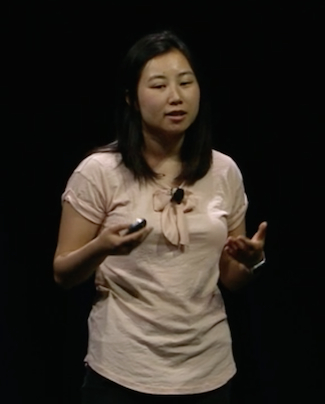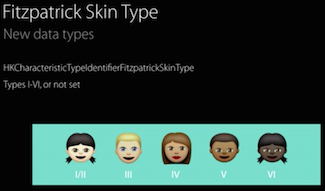 During Apple's recent World Wide Developer Conference an iOS Software Engineer named Shannon Tan gave a presentation for developers that discussed the new features added to HealthKit as part of the iOS 9 launch. As part of her presentation Tan provided additional perspective on Apple's recent forays into health as well as its decision-making process for how it chooses which new tracking fields to add to HealthKit.
During Apple's recent World Wide Developer Conference an iOS Software Engineer named Shannon Tan gave a presentation for developers that discussed the new features added to HealthKit as part of the iOS 9 launch. As part of her presentation Tan provided additional perspective on Apple's recent forays into health as well as its decision-making process for how it chooses which new tracking fields to add to HealthKit.
"Right now personal health is an extremely exciting area," Tan told developers at the WWDC event. "There are a lot of apps that are focusing on helping our users get and stay healthy. Devices like activity trackers and smartwatches are recording large amounts of extremely personal and relevant data. HealthKit is a framework that makes it easier to store and retrieve this information. It provides a rich set of APIs to save and access health and fitness data and share it between applications while maintaining security with extensive privacy settings and encrypted databases. So what does this mean for you as an app developer? It means that you can skip writing custom code to share, store, and sync data. Instead, you can focus on features that are core to your app experience while being part of a great ecosystem. Finally, with HealthKit comes a Health app, which provides a general into HealthKit. And in iOS9 we’ve added even more views to make it even easier for users to store, summarize, and correlate their data."
Tan said that one common question Apple gets from developers is how it prioritizes which types of data Apple adds to HealthKit. Tan said that the availability of hardware is Apple's first consideration for weighing whether to add a new data field to HealthKit, followed by the existence of health app or other software to support it. The third consideration is whether users or developers have requested a particular data field.
"Our highest priority consideration is the existence of hardware," Tan said. "For example, there are Bluetooth scales that automatically track weight and sleep trackers that measure your sleep activity. We find the possibility of automatic, quantified health data syncing to HealthKit on your device to be powerful. We also add data types based on the existence of software. What are the popular apps that already exist to create an experience around that data type? Finally, we consider customer and developer feedback."
Tan then described the three new types of data that were recently added to HealthKit: water intake, UV exposure, and reproductive health.
 "The first one is water intake," Tan said. "I’m sure we all know someone who lugs around a gigantic water bottle, and, when asked, explains that daily hydration is important to wellbeing and it’s probably bad for you to be thirsty all the time. There are a lot of apps in the AppStore that gently nudge you to increase your water intake and even some use things like Bluetooth sensors to track your water intake."
"The first one is water intake," Tan said. "I’m sure we all know someone who lugs around a gigantic water bottle, and, when asked, explains that daily hydration is important to wellbeing and it’s probably bad for you to be thirsty all the time. There are a lot of apps in the AppStore that gently nudge you to increase your water intake and even some use things like Bluetooth sensors to track your water intake."
Tan then discussed the new UV exposure data field and revealed that as part of this new data type, Apple would ask users to identify their skin type in order to tailor UV exposure tracking to the individual.
"UV radiation is present in sunlight and it has harms and benefits to human health," Tan said. "It can stimulate the production of Vitamin D and improve mood and wellbeing, however, over exposure also has negative effects. It can have negative effects like sunburn, or longterm effects like skin damage or cataracts. If you spend a lot of time in the sun, it might be useful to know when you are at most risk for sun damage. There are also nifty devices that track a person’s exposure to UV rays. For apps and sensors that do so, we’re adding in a new quantity type called UV Exposure. It’s value is a scalar: It represents the UV index from 0 to 12, from least to most dangerous."
Tan continued: "Of course, UV exposure isn’t a perfect way to measure your risk for sun damage. It can depend on the clothing you are wearing, the sunscreen you have on, or the skin type you have. For the last purpose we have added a new characteristic to HealthKit called Fitzpatrick Skin Type. This represents the skin type of an individual based on the Fitzpatrick scale, which is based on the degree of burning or tanning. So the emojis in iOS 8.3 are based on the Fitzpatrick scale. Way on the left is Type 1, which is very pale skin that burns quite rapidly and all the way on the right is dark brown or black skin, which never burns and tans profusely."
Tan also revealed that the new data types related to reproductive health tracking were the number one most requested HealthKit feature by developers.
"When we think about quantified health we often think about technologically-driven items like activity trackers and smartwatches," she said. "We think about HealthKit syncing your workouts or your food diary automatically logging your nutrition. But reproductive health is also a major component of health. For many women who track their health data, nothing has been as exciting or revealing as tracking their menstrual cycles. And for many couples who are trying to conceive, and many couples who are trying not to conceive, monitoring fertile times and understanding hormonal changes or irregularities, is critical information. It might seem strange to talk about data that is so sensitive and so intimate, yet when we talk about technology changing lives, this is vital, revealing, and insightful information. It helps women understand and be more aware of their bodies and to be in control of their health. It helps and has helped millions of people make informed decisions about their fertility and family planning."













